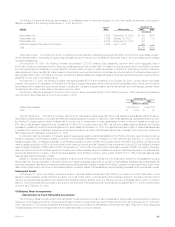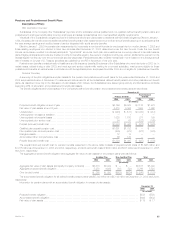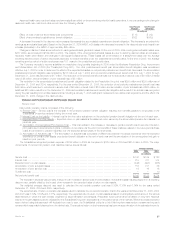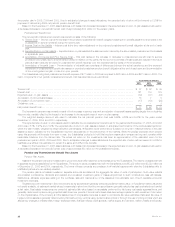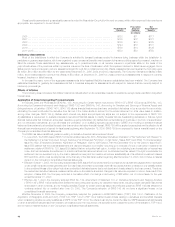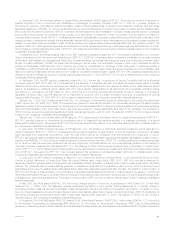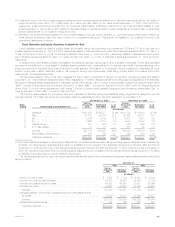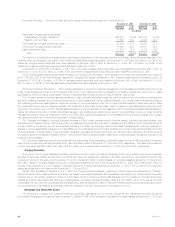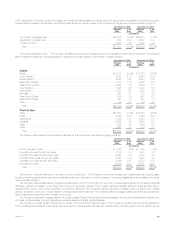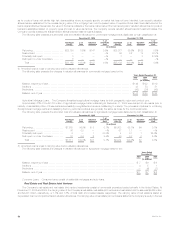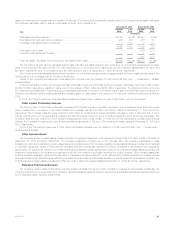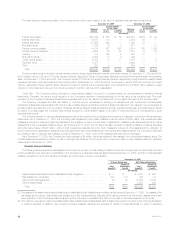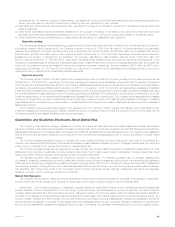MetLife 2005 Annual Report Download - page 46
Download and view the complete annual report
Please find page 46 of the 2005 MetLife annual report below. You can navigate through the pages in the report by either clicking on the pages listed below, or by using the keyword search tool below to find specific information within the annual report.to finance its activities without additional subordinated support from other parties. Effective February 1, 2003, the Company adopted FIN 46 for VIEs
created or acquired on or after February 1, 2003 and, effective December 31, 2003, the Company adopted FIN 46(r) with respect to interests in entities
formerly considered special purpose entities (‘‘SPEs’’), including interests in asset-backed securities and collateralized debt obligations. The adoption of
FIN 46 as of February 1, 2003 did not have a significant impact on the Company’s consolidated financial statements. The adoption of the provisions of
FIN 46(r) at December 31, 2003 did not require the Company to consolidate any additional VIEs that were not previously consolidated. In accordance
with the provisions of FIN 46(r), the Company elected to defer until March 31, 2004 the consolidation of interests in VIEs for non-SPEs acquired prior to
February 1, 2003 for which it is the primary beneficiary. As of March 31, 2004, the Company consolidated assets and liabilities relating to real estate joint
ventures of $78 million and $11 million, respectively, and assets and liabilities relating to other limited partnerships of $29 million and less than $1 million,
respectively, for VIEs for which the Company was deemed to be the primary beneficiary. There was no impact to net income from the adoption of FIN 46.
Effective January 1, 2003, the Company adopted FIN No. 45, Guarantor’s Accounting and Disclosure Requirements for Guarantees, Including
Indirect Guarantees of Indebtedness of Others (‘‘FIN 45’’). FIN 45 requires entities to establish liabilities for certain types of guarantees and expands
financial statement disclosures for others. The initial recognition and initial measurement provisions of FIN 45 were applicable on a prospective basis to
guarantees issued or modified after December 31, 2002. The adoption of FIN 45 did not have a significant impact on the Company’s consolidated
financial statements.
Effective January 1, 2003, the Company adopted SFAS No. 146, Accounting for Costs Associated with Exit or Disposal Activities (‘‘SFAS 146’’).
SFAS 146 requires that a liability for a cost associated with an exit or disposal activity be recorded and measured initially at fair value only when the liability
is incurred rather than at the date of an entity’s commitment to an exit plan as required by EITF Issue No. 94-3, Liability Recognition for Certain Employee
Termination Benefits and Other Costs to Exit an Activity Including Certain Costs Incurred in a Restructuring (‘‘EITF 94-3’’). As required by SFAS 146, the
Company adopted this guidance on a prospective basis which had no material impact on the Company’s consolidated financial statements.
Effective January 1, 2003, the Company adopted SFAS No. 145, Rescission of FASB Statements No. 4, 44, and 64, Amendment of FASB
Statement No. 13, and Technical Corrections (‘‘SFAS 145’’). In addition to amending or rescinding other existing authoritative pronouncements to make
various technical corrections, clarify meanings, or describe their applicability under changed conditions, SFAS 145 generally precludes companies from
recording gains and losses from the extinguishment of debt as an extraordinary item. SFAS 145 also requires sale-leaseback treatment for certain
modifications of a capital lease that result in the lease being classified as an operating lease. The adoption of SFAS 145 did not have a significant impact
on the Company’s consolidated financial statements.
Investments
The Company’s primary investment objective is to optimize, net of income taxes, risk-adjusted investment income and risk-adjusted total return while
ensuring that assets and liabilities are managed on a cash flow and duration basis. The Company is exposed to three primary sources of investment risk:
)Credit risk, relating to the uncertainty associated with the continued ability of a given obligor to make timely payments of principal and interest;
)Interest rate risk, relating to the market price and cash flow variability associated with changes in market interest rates; and
)Market valuation risk.
The Company manages risk through in-house fundamental analysis of the underlying obligors, issuers, transaction structures and real estate
properties. The Company also manages credit risk and market valuation risk through industry and issuer diversification and asset allocation. For real
estate and agricultural assets, the Company manages credit risk and valuation risk through geographic, property type and product type diversification and
asset allocation. The Company manages interest rate risk as part of its asset and liability management strategies, product design, such as the use of
market value adjustment features and surrender charges, and proactive monitoring and management of certain non-guaranteed elements of its products,
such as the resetting of credited interest and dividend rates for policies that permit such adjustments. The Company also uses certain derivative
instruments in the management of credit and interest rate risks.
MetLife, Inc. 43


